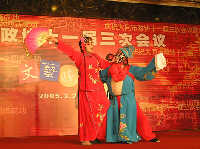 Shuahai'er, also known asheheqiang, is a local opera greatly favored by the people aroundDatongarea ofShanxi Province. The most prominent feature about the opera lies in the employment of "back throat" singing, namely, the voice is produced from under the throat, thus sounding deep and rustic.
Shuahai'er, also known asheheqiang, is a local opera greatly favored by the people aroundDatongarea ofShanxi Province. The most prominent feature about the opera lies in the employment of "back throat" singing, namely, the voice is produced from under the throat, thus sounding deep and rustic.
Theshuahai'ervocalizations may sound a bit odd and unscientific to outsiders who listen to it for the first time, but gradually, they some learn to love it. The locals, however, love to see and hear such arias. When some artists tried to change the back-throat to front-throat vocalization, the audience, believing the vocalization was the essence of shuahai'er, refused to accept the change.
The history ofshuahai'ercan be traced to the reign of Daoguang Emperor of theQing Dynasty, or even before that. At the very beginning, it was only performed in Yingxian and Huairen counties of Shanxi Province, but gradually spread to other parts of the area. It is saidshuahai'erart reached its climax by the late Qing Dynasty, when many troupes of various local operas sprang up like bamboo shoots after a spring rain. In order to elevate the reputation of their own troupes, the troupe leaders launched contests, in which the shuahai'ertroupes would always be the winner.
Arias inshuahai'erare framed by the main tunes, which are beset with other small tunes, includingxibozi(happy cymbals),kubozi(bitter cymbals),banbozi(half cymbals), and so on. In terms of emotion expressions,shuahai’erhas assimulated the singing of "jieban" and "gunbai" in bangzi opera (local operas performed to the accompaniment of bamboo or wooden clappers).
The traditionalshuahai'erhas two categories: civil and military. Big banhu, or board fiddle, and big flutes are employed for the former, while small and big gongs, drums and cymbals are used for the latter.
After liberation in 1949, a professional shuhai'er troupe was established, with numerous amateur troupes in the countryside.
Author: Jessie
